The Samsung 870 EVO (1TB & 4TB) Review: Does the World Need Premium SATA SSDs?
by Billy Tallis on February 17, 2021 8:00 AM ESTMixed IO Performance
For details on our mixed IO tests, please see the overview of our 2021 Consumer SSD Benchmark Suite.
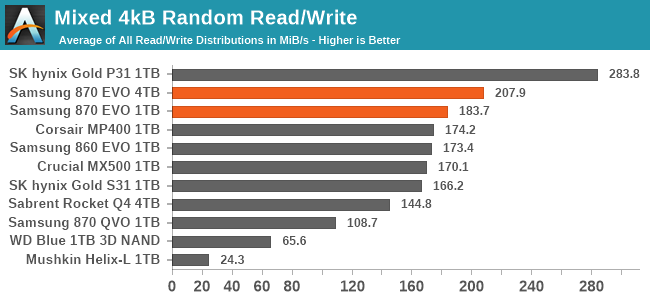 |
|||||||||
| Mixed Random IO | Mixed Sequential IO | ||||||||
The mixed random IO test provides the Samsung 870 EVO with one of its biggest performance wins yet over the rest of the SATA field and the entry-level NVMe competition. But most of that comes from the capacity advantage the 4TB model has over most of these comparison drives; the 1TB 870 EVO is only about 5% faster overall than the 860 EVO. On the mixed sequential IO test, the SATA bottleneck keeps most of the performance scores within a fairly narrow range, and the 1TB 870 EVO's performance is actually a bit of a regression compared to its predecessor.
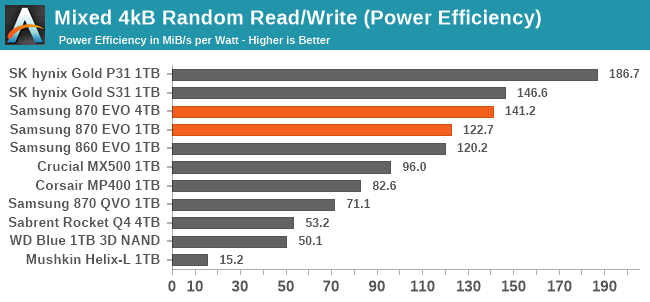 |
|||||||||
| Mixed Random IO | Mixed Sequential IO | ||||||||
As with our separate tests of random reads and writes, the top efficiency scores for mixed random IO go to SK hynix, with Samsung's TLC drives turning in the next best scores and having a clear advantage over other competing brands. Over on the sequential IO side of things, the efficiency scores more closely mirror the performance scores, and the 870 EVO doesn't have any real advantage over other mainstream SATA drives.
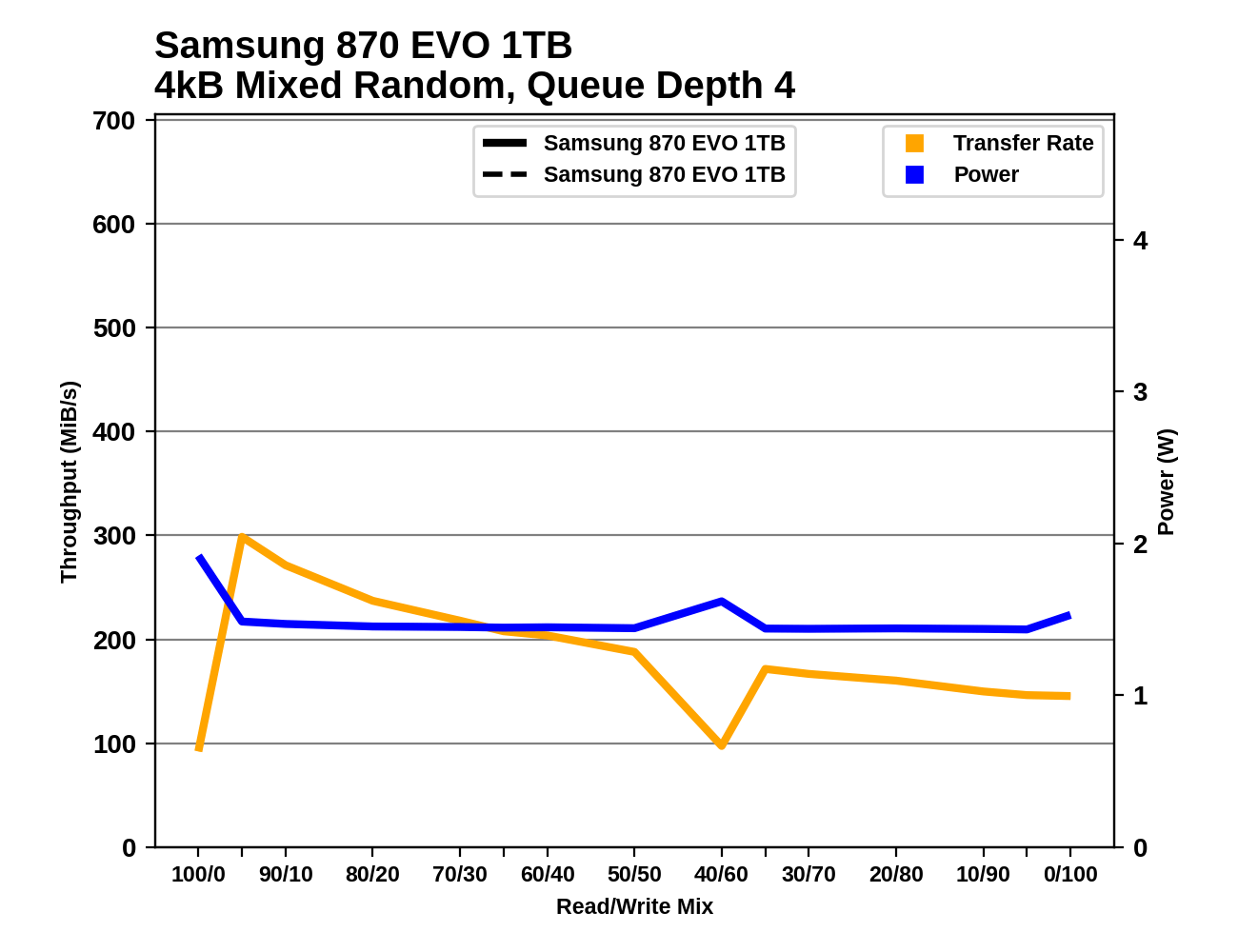 |
|||||||||
| Mixed Random IO | |||||||||
| Mixed Sequential IO | |||||||||
The 1TB 870 EVO's performance during the mixed random IO test is more consistent than the 860 EVO's, but still has a few unpleasant drops that aren't present for the 4TB model. On the mixed sequential IO test, the 1TB 870 EVO's performance is actually a bit less consistent than the 860 EVO. But aside from those occasional outliers, the general trend is for the 870 EVO to provide superior random IO performance and link-saturating sequential performance across a wide range of workload mixes.
Idle Power Management
Real-world client storage workloads leave SSDs idle most of the time, so the active power measurements presented earlier in this review only account for a small part of what determines a drive's suitability for battery-powered use. Especially under light use, the power efficiency of a SSD is determined mostly be how well it can save power when idle.
SATA SSDs are tested with SATA link power management disabled to measure their active idle power draw, and with it enabled for the deeper idle power consumption score and the idle wake-up latency test. Our testbed, like any ordinary desktop system, cannot trigger the deepest DevSleep idle state. For more details, please see the overview of our 2021 Consumer SSD Benchmark Suite.
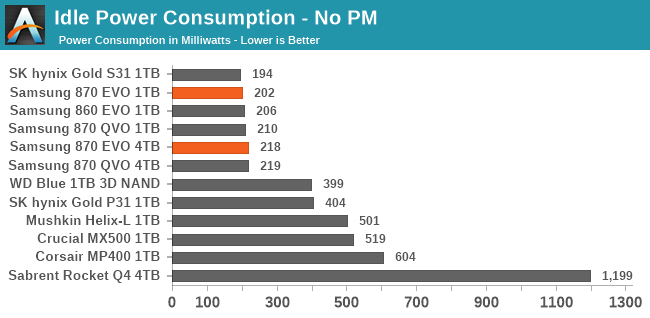
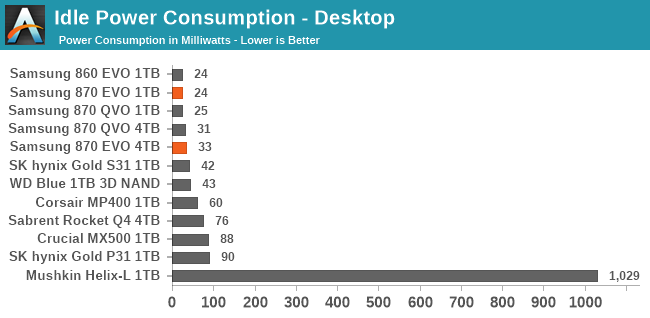
The Samsung 870 EVO may feature an updated controller compared to the 860 EVO, but there's no real difference in idle power consumption, for either active idle or the desktop (non-DevSleep) idle states. Samsung's idle power figures are best in class, with SK hynix offering the only close competition.
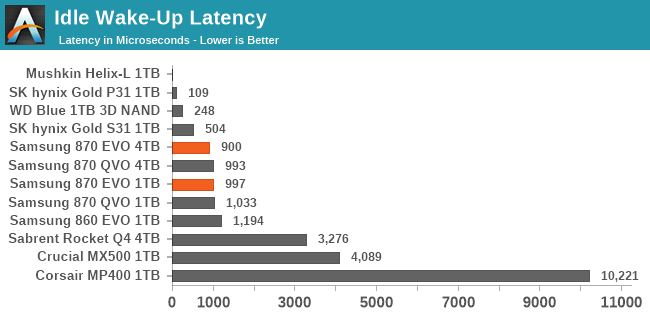
The Samsung SATA drives all take about one millisecond to wake up from using SATA link power management. This is higher than several of the other SATA drives, but not really enough to be of much concern for system responsiveness.










136 Comments
View All Comments
Marlin1975 - Wednesday, February 17, 2021 - link
So with high capacity SSD becoming more common and cheaper is there any movement to update the SATA standard to take advantage?Seems hard drive makers would be trying to get this to happen. Even a small performance boost would sell larger capacity SSDs.
ckmac - Wednesday, February 17, 2021 - link
Nope. Back in 2013-14, there was a new standard named "SATA Express", but it never gained any traction in the marketplace. That's why SSDs have moved to the M.2 form factor, with the PCIe interface. There's much more bandwidth:PCIe 3.0 x4 = 3.938 GB/s = 31.5 Gbps
PCIe 4.0 x4 = 7.877 GB/s = 63.0 Gbps
The same form factor can be used in laptops, desktops, consoles, etc. Newer motherboards have 2 to 3 total M.2 slots.
SarahKerrigan - Wednesday, February 17, 2021 - link
I have a SATA Express laptop! The complete lack of drives for the form factor aside from the one it shipped with (an OEM-specific Toshiba XG3 iirc) is somewhat annoying - but luckily there's an M.2 adapter available in a pinch.DanNeely - Wednesday, February 17, 2021 - link
Sata Express isn't even really an update of SATA. They just added the ability to run 2 PCIe lanes instead of a SATA link down the cable; effectively making it equivalent to a low end m.2 drive.Kamen Rider Blade - Wednesday, February 17, 2021 - link
The issue with the M.2 connector is that it wasn't designed for "Hot Swap"and the designed in Insertion life isn't high compared to the SATA style connector
- M.2 = ____ 50 Cycles
- SATA = 10,000 Cycles
Murloc - Wednesday, February 17, 2021 - link
even hobby builders who upgrade their components often are likely to touch that maybe once every year at most. And the motherboard is unlikely to last more than 5 years if they're that upgrade-crazy.mr_tawan - Thursday, February 18, 2021 - link
well what about M.2 replace SD standard ? Maybe it can becomes pro-level video camera storage. Having 50 cycles of hot swap seems to be mis-opportunity.dotjaz - Friday, February 19, 2021 - link
why would they need that? Why are you creating problem when it's not there?M.2 can't hotswap at all. It's physically too big. You'll need to completely redesign the physical and protocol layer. Why wouldn't you just use SD Express?
MetaCube - Thursday, March 18, 2021 - link
WtfCaedenV - Wednesday, February 17, 2021 - link
I mean... with SATA drives/cables, then you need to unhook and reattach them all the time because the wires get in the way. m.2 is just on the mobo, so you don't need to ever mess with it unless the mobo is being replaced, or you are upgrading.